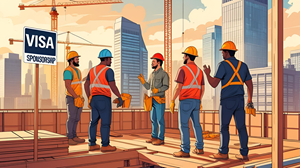Introduction: Why Consider a Construction Job in the USA?
Construction Job in USA with Visa Sponsorship can be easily acquired as the construction industry in the USA is booming, driven by infrastructure upgrades, housing projects, and urban expansion. With a labor shortage in many states, American companies are increasingly open to hiring foreign workers for construction jobs—especially those with experience and trade skills. The good news? Many of these jobs now come with visa sponsorship, offering a legal pathway to live and work in the U.S.
This article explores everything you need to know about securing a construction job in the USA with visa sponsorship, including job roles, salaries, visa types, and how to apply.
What is a Construction Job in the USA?
A construction job involves building, repairing, and maintaining infrastructure—residential buildings, highways, commercial centers, bridges, and more. These jobs can be physically demanding but offer competitive pay, on-the-job training, and career advancement.
Common Roles in Construction:
- General laborers
- Carpenters
- Electricians
- Plumbers
- Welders
- Heavy equipment operators
- Site supervisors
Each of these roles may have specific licensing requirements, which vary by state. However, many employers offer training and certification support—especially if they are sponsoring your visa.
HOW TO APPLY FOR USA VISA LOTTERY.
Why Choose a Construction Job with Visa Sponsorship?
Visa sponsorship means a U.S. employer is willing to petition the U.S. government to allow a foreign national to work legally in the United States. This is a huge advantage for foreign applicants who wish to relocate for work.
Benefits of Jobs with Visa Sponsorship:
- Legal work authorization
- Competitive salaries and overtime
- Health insurance and retirement benefits
- Path to permanent residency (Green Card)
- Better living standards and job security
Types of U.S. Visas for Construction Workers
Understanding visa options is crucial. Here are the most common visas offered for construction jobs:
H-2B Visa (Temporary Non-Agricultural Worker Program)
- For seasonal or peak-load positions
- Typically valid for up to 9 months, extendable to 3 years
- Requires employer to prove no qualified U.S. workers are available
EB-3 Visa (Skilled or Other Workers)
- For skilled laborers and professionals
- Offers a path to permanent residency
- Employer must file a labor certification (PERM)
TN Visa (for Canadian and Mexican Citizens)
- Fast-track visa for NAFTA/USMCA countries
- Valid for specific occupations in engineering, surveying, etc.
Pro Tip: Always ensure your potential employer is eligible and willing to file a petition with USCIS (U.S. Citizenship and Immigration Services).
Who is Eligible to Apply?
Not everyone qualifies for these positions, especially under U.S. immigration laws. However, if you meet the following criteria, your chances are strong:
Basic Requirements:
- Must be 18+ years old
- Physically fit and able to perform labor-intensive tasks
- Have a minimum of high school education (varies by role)
- Experience in construction or a relevant trade is preferred
- Clean background and medical record
Some jobs may require trade certifications, OSHA safety training, or state-specific licenses (especially for electricians and plumbers).
Top U.S. Companies Offering Construction Jobs with Sponsorship
Many reputable U.S. companies sponsor foreign workers due to ongoing labor shortages. Some of them include:
1. Bechtel Corporation
One of the largest construction and engineering firms in the U.S., known for sponsoring workers on the EB-3 visa.
2. Kiewit Corporation
Frequently hires skilled labor and construction managers and supports green card sponsorship.
3. Fluor Corporation
Engages in large-scale international projects, often requiring skilled foreign workers.
4. Turner Construction
Actively supports diversity and includes sponsored roles in their workforce plans.
5. Jacobs Engineering
Known for hiring engineers and site supervisors under TN and H-1B categories.
Tip: Check their official websites or careers section for “visa sponsorship available” or “international applicants welcome.”
How Much Can You Earn in a Construction Job in the USA?
Construction jobs in the U.S. are among the highest-paying blue-collar jobs globally. Here’s what you can expect:
| Job Title | Average Hourly Rate | Annual Salary (Approx.) |
|---|---|---|
| General Laborer | $18 – $25 | $35,000 – $50,000 |
| Electrician | $25 – $40 | $50,000 – $85,000 |
| Welder | $20 – $35 | $40,000 – $70,000 |
| Heavy Equipment Operator | $22 – $38 | $45,000 – $75,000 |
| Site Supervisor | $30 – $55 | $60,000 – $110,000 |
Salaries may be higher in cities like New York, California, and Texas, where demand for construction labor is especially strong.
Where to Find These Jobs
You can search for sponsored construction jobs using job portals and direct applications.
Recommended Job Sites:
- Indeed.com
- LinkedIn.com
- Glassdoor.com
- SimplyHired.com
- SeasonalJobs.dol.gov – official U.S. government site for H-2B jobs
When searching, use keywords like “construction jobs with visa sponsorship,” or “H-2B construction laborer USA.”
Step-by-Step: How to Apply for a Construction Job in the USA with Visa Sponsorship
- Create a U.S.-style resume highlighting construction experience.
- Find a job listing that states visa sponsorship is offered.
- Apply directly through the company’s portal or job board.
- Attend interviews (virtual or in-person) and verify sponsorship support.
- Employer files a visa petition on your behalf (Form I-129 or PERM).
- Attend U.S. Embassy interview in your country once approved.
- Receive your visa and travel to the U.S. to begin work.
- Stay honest in your application
- Never pay an employer to “sponsor” you — it’s often a scam
- Focus on upgrading your skills (e.g., OSHA safety certification, trade licenses)
- Build a strong professional profile on LinkedIn and apply early (especially before seasonal peaks)
Conclusion
A construction job in the USA with visa sponsorship offers an excellent opportunity to build a stable, well-paying career in one of the world’s largest economies. With the right skills and resources, you can transition from an international job seeker to a permanent resident in the U.S.
Keep in mind that while the process can be competitive, it’s far from impossible—especially as U.S. demand for skilled construction labor continues to grow.

